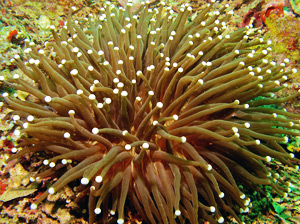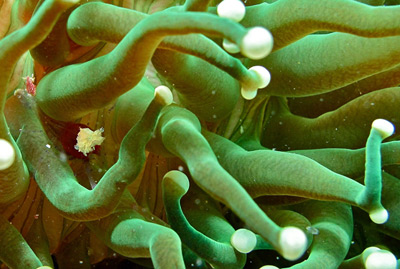Easily mistaken for an anemone at first glance, Heliofungia actiniformis is a large-polyp stony (LPS) coral that can be an excellent option for reefkeepers with modest-sized systems. Even relative newcomers to the reefkeeping hobby can succeed with this species, provided they make the effort to satisfy its few special care requirements.
Physical traits
Commonly known as the long-tentacled plate coral or disk coral, H. actiniformis (the only member of its genus) has a disk-shaped skeleton very similar to that of its Fungia spp. cousins. However, as its common name implies, it differs in having much longer tentacles that are usually brown or green with bulbous, contrastingly colored (typically white or pink) tips, giving this coral a decidedly anemone-like appearance. It also produces long sweeper tentacles, with which it can sting neighboring cnidarians, and can inflate its tissues to surprising dimensions.
Lighting and water movement
H. actiniformis prefers moderate- to high-intensity lighting schemes as well as low to medium levels of water flow. You want just enough turbulent water movement to keep the tentacles swaying gently and help the animal rid itself of debris—not a powerful direct blast of linear current, which will stress the animal and likely cause it to keep its tentacles retracted.
Aquarium placement

This Indo-Pacific species is naturally solitary and free-living and, thus, belongs at the bottom of the tank on a sand or rubble substrate, not somewhere high up on the rockwork. Also, be sure to allow at least 6 to 8 inches of space between it and any other sessile invertebrates to prevent it from stinging—or, worse, being stung by—its neighbors. This last point is critical, as this species will likely come out the loser in any stinging match with an aggressive encroaching coral.
Of course, the system this species resides in must be big enough and aquascaped such to satisfy its need for substrate placement and ample “elbow room.” Thus, shorter, wider tanks are generally better choices than taller, narrower ones for housing H. actiniformis.
Feeding
Though H. actiniformis is zooxanthellate (meaning that given proper lighting, it derives much of the nutrition it needs from the photosynthetic zooxanthellae residing in its tissues), it tends to fare best in captivity when given regular supplemental feedings. Small, meaty food items, such as mysids or chopped fish, crustacean, or mollusk flesh, should be offered at least once weekly.



